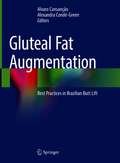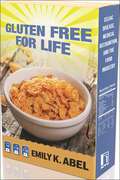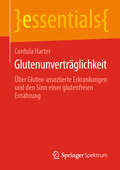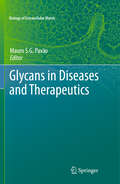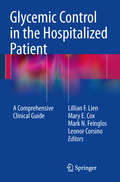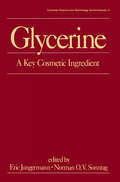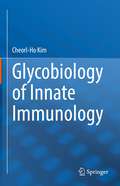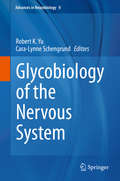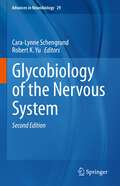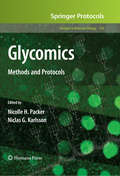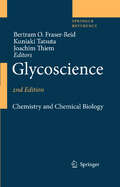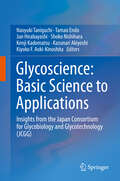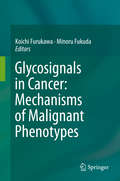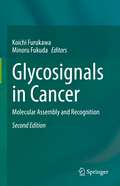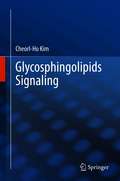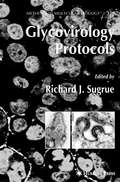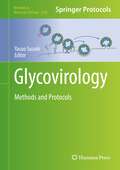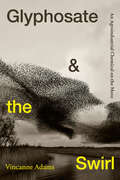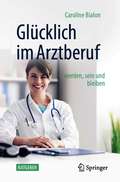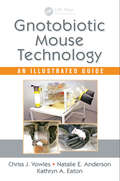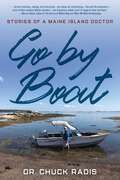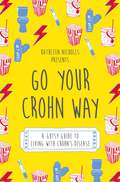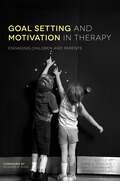- Table View
- List View
Gluteal Fat Augmentation: Best Practices in Brazilian Butt Lift
by Alvaro Cansanção Alexandra Condé-GreenBrazilian Butt Lift has been described by many, but there is no definitive resource or book that details the procedure as performed by Brazilian Plastic Surgeons. The editors conducted a recent survey among the members of the Brazilian Society of Plastic Surgeons (SBCP) and have seen that there are many differences in approach, style, technique, and even materials used between what is being done around the world and what is being done in Brazil. While addressing recent media attention and scares, this book features contributions from world renowned Brazilian and international Plastic Surgeons addressing the high morbidity and mortality recently reported and establish tried and true safety protocols. To increase the scope of the book, differing views of techniques and methods are also included, making this a truly global book covering the specific gluteal region.Gluteal Fat Augmentation: Best Practices in Brazilian Butt Lift will open with the history of the procedure, go through the anatomy and the ethnic aspects of the aesthetics of the gluteal region. The book features special chapters on gluteal fat augmentation and a wide variety of techniques to improve the gluteal contour. A wealth of images accompany the text to fully illustrate the different approaches and techniques of gluteal fat augmentation, reshaping, and contouring including the use of fillers, implants, lift, and correction of depressions and deformities of the region. Written for practicing plastic surgeons, this book is poised to become the go-to reference for cosmetic and reconstructive concerns surrounding the gluteal region.
Gluten Free for Life: Celiac Disease, Medical Recognition, and the Food Industry
by Emily K. AbelA groundbreaking exploration of celiac disease, a serious autoimmune condition that affects approximately three million Americans, or 1 percent of the populationThe manifestations of celiac disease–including anemia, gastrointestinal problems, and infertility–are diverse and can have severe consequences if left untreated. The only therapy is lifelong adherence to a gluten-free diet. Because many doctors know little about celiac, nearly half of the individuals with the disease remain undiagnosed, and many wait years for the correct diagnosis.In Gluten Free for Life, Emily K. Abel delves into the social, cultural, and historical dimensions of celiac disease, and sheds light on the challenges faced by affected individuals. The book uncovers the profit- driven motivations behind certain food companies, which often produce exorbitantly priced and ultraprocessed gluten-free products that remain out of reach for many people. Abel also emphasizes the parallels between celiac disease and other disabilities, stressing the condition's invisible nature. The absence of observable symptoms poses significant challenges in terms of social interactions, workplace dynamics, and the overall perception of those living with the disease.Abel cautions against viewing a medical cure as the sole solution for celiac disease. Instead, she advocates for a comprehensive approach that addresses the socioeconomic factors impacting adherence to the gluten-free diet. By redirecting attention toward necessary social and political reforms, Gluten Free for Life proposes remedies capable of alleviating the burdens faced by individuals with celiac disease.
Glutenunverträglichkeit: Über Gluten-assoziierte Erkrankungen und den Sinn einer glutenfreien Ernährung (essentials)
by Cordula HarterGlutenunverträglichkeit ist ein multifaktorielles Phänomen. Im medizinischen Kontext werden damit Symptome assoziiert, die nach dem Verzehr von glutenhaltigen Nahrungsmitteln auftreten. Jedoch sind nicht alle Fälle einer wahrgenommenen Glutenunverträglichkeit medizinisch diagnostizierbar. Nur für Zöliakie und Weizenallergien bestehen eindeutige Diagnosekriterien. In den meisten Fällen besteht eine Nicht-Zöliakie-Nicht-Weizenallergie-Weizensensitivität (NCWS). Gluten kann bei NCWS nur selten als verursachendes Agens nachgewiesen werden. Vielmehr kommen andere Inhaltsstoffe von Weizen, wie ATI oder FODMAP, oder eine gestörte intestinale Mikrobiota als Krankheitsauslöser in Frage. Cordula Harter stellt klar: Glutenunverträglichkeit ist ein Modetrend, dem viel mehr Menschen folgen, als es diagnostizierte Patienten gibt. Die Autorin zeigt, dass glutenhaltige Getreide ernährungsphysiologisch hochwertige Nahrungsmittel sind, die wertvolle Nährstoffe und Ballaststoffe liefern. Eine Eliminierung ist nur selten medizinisch indiziert und nutzt der Nahrungsmittelindustrie oft mehr als dem Verbraucher.Die Autorin:Dr. Cordula Harter ist Privatdozentin und Lehrkoordinatorin am Biochemie-Zentrum der Universität Heidelberg.
Glycans in Diseases and Therapeutics
by Mauro S.G. PavãoInitially believed to be inactive molecules, glycans are now considered essential for life, both under normal and pathological conditions. This volume of the series "Biology of Extracellular Matrix" reviews the most recent findings on the role of glycans in the development of diseases and the possible therapeutic use of this class of molecules. It shows how the interaction of glycans with growth factors, growth factor binding proteins, extracellular proteases, protease inhibitors, chemokines, morphogens, and adhesive proteins regulates inflammation, infection, cancer, atherosclerosis, thrombosis and embryonic stem cell biology. Furthermore, an extensive survey about the structure and pharmacological effects of unique marine glycosaminoglycans is discussed as well as the possibility of using these glycans as therapeutic agents.
Glycemic Control in the Hospitalized Patient
by Lillian F. Lien Leonor Corsino Mark N. Feinglos Mary E. CoxGlycemic Control in the Hospitalized Patient: A Comprehensive Clinical Guide is a unique, practical resource for health care providers dealing with hyperglycemia in the inpatient setting. Outlining a hands-on approach used by the Duke University Inpatient Diabetes Management team, the book discusses a wide range of scenarios that occur while treating patients with hyperglycemia, including challenging circumstances such as steroids and tube feeding regimens. Special emphasis is given to insulin therapy. The chapters are written by a group of health care providers with extensive, pioneering experience in hyperglycemia control in the inpatient setting at the Duke University Medical Center. The book includes the most up-to-date scientific evidence and information and is addressed to not only hospitalists and general internists but also endocrinology fellows, residents, nurse practitioners, nurses, and other primary care practitioners who treat patients in the inpatient setting. The focus is clearly on practical, patient-care topics. Glycemic Control in the Hospitalized Patient: A Comprehensive Clinical Guide is a first-of-its kind, comprehensive guide to state-of-the-art inpatient glycemic management.
Glycerine: A Key Cosmetic Ingredient
by Eric Jungermann Norman O.V. SonntagThis book comprehensively covers the chemical and physical properties and manufacturing and handling procedures of glycerine and the use of this material in cosmetic and personal care products and in other industrial areas such as testing laboratories and manufacturing and marketing sectors.
Glycobiology of Innate Immunology
by Cheorl-Ho KimThis book presents the latest knowledge and the most recent research results on glycobiology of innate immunology. Innate immunity is the crucial part of the immunological defense system that exerts their distinct functions through binding to certain functional glycoproteins. They play a role in various human diseases and also function against microbial invaders and self-associated molecular patterns. Co-regulated expression of glycan-binding is associated with many biological components such as cellular oncotransformation, phenotype change, neuronal or embryonic development, regulation of cell division, cell–cell interaction, cell attachment, adhesion, and motility, and intracellular signaling via protein–carbohydrate or carbohydrate–carbohydrate interactions.This book opens by providing the key background on glycans in innate immunity and its mechanisms behind the Dendritic cell interactions during infection and inflammation are examined in depth, and the concluding chapter is devoted to signaling tumor immunotherapy. Up-to-date information is then presented on all aspects of glycan structure-recognizing signaling. The book should assist in the further development of new strategies against emerging infectious agents and intractable diseases.
Glycobiology of the Nervous System
by Robert K. Yu Cara-Lynne SchengrundA thorough introduction is provided to the variety and complexity of the roles that glycoconjugates play in the cells of the nervous system. Basic information as well as the latest developments in neural glycobiology are discussed. Topics covered range from the structure and metabolism of the saccharide chains and current approaches used in their study, to changes glycoconjugates undergo during development and aging of the nervous system and the roles they have in neurological disease. The breadth and depth of topics covered make it an essential reference for those new to the field as well more seasoned investigators.
Glycobiology of the Nervous System (Advances in Neurobiology #29)
by Robert K. Yu Cara-Lynne SchengrundThis new edition provides comprehensive coverage of the variety and complexity of the roles that glycoconjugates play in the cells of the nervous system. Basic fundamental principles as well as the latest developments in neural glycobiology are discussed. Topics covered range from the structure and metabolism of the saccharide chains and current approaches used in their study, to changes glycoconjugates undergo during development and aging of the nervous system and the roles they have in neurological disease. New topics include a detailed discussion of cells found within the nervous system, an extensive listing of congenital disorders of glycosylation of both proteins and lipids, the roles of glycans in neuronal axon growth/guidance and voltage-gated channels, the role of intra-lysosomal luminal vesicles in lysosomal storage disorders, and, in the time of the COVID-19 pandemic, the role of carbohydrates in infection by SARS-CoV-2. The breadth and depth of topics covered make this an essential reference for those new to the field as well as for more experienced investigators.
Glycomics
by Nicolle H. Packer Niclas G. KarlssonDue to the significant contributions of carbohydrates to the functional diversity of the cell, the challenging study of the glycome has expanded beyond the research of carbohydrate experts and into the wider scope of the life sciences. To aid all scientists now delving into this vital subject area, Glycomics: Methods and Protocols collects a compendium of detailed laboratory protocols reflecting the increasing availability of sample preparation, chromatographic, electrophoretic, mass spectrometric, and bioinformatic tools specifically designed for the analysis of glycosylation. Leading researchers in the field address subjects such as glycoprotein and proteoglycan analysis, glycosylation structure determination, as well as various approaches to investigate the interaction between glycans and a variety of carbohydrate-recognizing proteins in order to aid exploration into the functional significance of the oligosaccharides. Written in the highly successful Methods in Molecular BiologyTM series format, the chapters include introductions to their respective topics, lists of the necessary materials and reagents, step-by-step, readily reproducible protocols, and notes on troubleshooting and avoiding known pitfalls. Authoritative and cutting-edge, Glycomics: Methods and Protocols serves as a valuable guide for experimenters facing the challenges of glycan analysis in hope of providing further insights into the biology of cell-cell communication and interaction.
Glycoscience
by Shin-Ichiro Nishimura Sabine Flitsch Bertram O. Fraser-Reid Biao Yu Joachim Thiem Kuniaki Tatsuta Yukishige Ito Hirosato Kondo Gregory L. CotéAs a reflection of the quantum leap that has been made in the study of glycostructures, the first edition of this book has been completely revised and updated. The editors give up-to-date information on glycostructures, their chemistry and chemical biology in the form of a completely comprehensive survey. Glycostructures play highly diverse and crucial roles in a myriad of organisms and important systems in biology, physiology, medicine, bioengineering and technology. Only in recent years have the tools been developed to partly understand the highly complex functions and the chemistry behind them. While many facts remain undiscovered, this MRW has been contributed to by a large number of the world's leading researchers in the field.
Glycoscience: Insights from the Japan Consortium for Glycobiology and Glycotechnology (JCGG)
by Naoyuki Taniguchi Jun Hirabayashi Tamao Endo Kiyoko F. Aoki-Kinoshita Shoko Nishihara Kenji Kadomatsu Kazunari AkiyoshiThis book presents the state of the art in glycoscience and proposes a road map for the coming decade, focusing on the potential of glycoscience research to shed light on important basic science issues and give rise to exciting new applications, especially in the field of diagnosis and therapeutics. Individual sections offer in-depth coverage of various topics relating to glycans and biopharmaceuticals, glycans in medical science and medicine, glycan technologies, glycans in food and nutrients, and glycan-related materials and their uses. In addition, the book presents an exemplary training course on glycomics and highlights educational and analytical web resources, and also includes glossaries and boxes summarizing key facts to ensure ease of understanding for non-expert readers and students. Written by more than 150 active participants in the Japan Consortium for Glycobiology and Glycotechnology (JCGG), whose goal is to promote the development of interdisciplinary glycoscience and establish a global network in the field, it is a valuable resource for students, postdocs, and researchers in the life sciences as well as for stakeholders and professionals in government, funding agencies and industry.
Glycosignals in Cancer: Mechanisms of Malignant Phenotypes
by Koichi Furukawa Minoru FukudaThis book is a collection of cutting-edge studies on the functions and mechanisms of glycosylation in cancers. Along with progress in genomics and proteomics, new findings in the significance of these complex carbohydrates, through the regulation of cell signals, have been elucidated in a wide variety of biological events. This volume provides a comprehensive summary of glycosignals and their involvement in cancer, covering numerous topics such as glycosylation machineries, regulation of phenotypes, cell signaling, immune regulation, complex carbohydrate organization, and clinical applications. The contents have been organized to promote ready understanding, covering basic to clinical research and studies on micromolecules, to animal/human cells and tissues. This book is an essential read for students and young researchers interested in cancers and carbohydrates. Specialists in glycobiology will also benefit from the new results and approaches detailed here, which provide insights into future directions of functional studies of sugar chains in both basic and applied research.
Glycosignals in Cancer: Molecular Assembly and Recognition
by Koichi Furukawa Minoru FukudaThis book, now in an extensively revised second edition, provides a comprehensive summary of the latest knowledge regarding glycosignals and a thorough analysis of their involvement in not only cancers but also other refractory conditions such as chronic inflammatory disorders. Many relevant topics are covered, including the search for novel tumor epitopes related to carbohydrates, the assembly of glycoconjugates, the modulation of signaling pathways by glycosylation, and interactions between complex carbohydrates and their recognition molecules. The role of various research approaches, for example advanced mass spectrometry, high-resolution imaging, and bioinformatics, is closely examined, and the results of novel therapeutic trials targeting glycosignals are discussed. The book will be essential reading for students and young researchers with an interest in glycoscience. In presenting new results and approaches and identifying areas for future research, it will also be of benefit for specialists in the field.
Glycosphingolipids Signaling
by Cheorl-Ho KimThis book presents the latest knowledge and the most recent research results on glycosphingolipid (GSL)-mediated signaling. GSLs are important constituents of the plasma membrane that exert their distinct functions through binding to certain functional proteins. They play a role in various human diseases and also function as human alloantigens. Cellular GSLs are associated with many biological functions such as cellular oncotransformation, phenotype change, neuronal or embryonic development, regulation of cell division, cell–cell interaction, cell attachment, adhesion, and motility, and intracellular signaling via protein–carbohydrate or carbohydrate–carbohydrate interactions. This book opens by providing the key background on GSL glycan–receptor interactions and mammalian GSL synthesis. Up-to-date information is then presented on all aspects of GSL-dependent signaling. Viral protein and bacterial toxin protein interactions with host cell GSLs are examined in depth, and the concluding chapter is devoted to signaling regulation. The book should assist in the further development of new strategies against emerging infectious agents and intractable diseases.
Glycosylation Engineering of Biopharmaceuticals
by Alain BeckGlyco-engineering is being developed as a method to control the composition of carbohydrates and to enhance the pharmacological properties of monoclonal antibodies (mAbs) and other proteins. In Glycosylation Engineering of Biopharmaceuticals: Methods and Protocols, experts in the field provide readers with production and characterization protocols of glycoproteins and glyco-engineered biopharmaceuticals with a focus on mAbs. The volume is divided in four complementary parts dealing with glyco-engineering of therapeutic proteins, glycoanalytics, glycoprotein complexes characterization, and PK/PD assays for therapeutic antibodies. Written in the highly successful Methods in Molecular BiologyTM series format, chapters include introductions to their respective topics, lists of the necessary materials and reagents, step-by-step, readily reproducible laboratory protocols, and tips on troubleshooting and avoiding known pitfalls. Authoritative and cutting-edge, Glycosylation Engineering of Biopharmaceuticals: Methods and Protocols serves as an ideal guide for scientists striving to push forward the exciting field of engineered biopharmaceuticals.
Glycovirology Protocols
by Richard J. SugrueThis volume reviews the increasing importance of glycosylation to the field of virology, as well as virus replication. The chapters provide an overview of glycosylation in relation to virus infection, and the generic techniques that are used to analyze and characterize glycoproteins. The information presented here provides insight as to how the techniques of glycobiology can be applied in virology and answer most questions that are of interest to the reader.
Glycovirology: Methods and Protocols (Methods in Molecular Biology #2556)
by Yasuo SuzukiThis volume details applications in molecular biological techniques and focuses on applications to determine the involvement of glycans in virus interactions. Chapters guide readers through glycan analysis, glycan distribution analysis, glycan and lectin microarray, preparation of recombinant viral domain protein, reverse genetics and receptor binding, virus-host interactions and receptor binding, and sialidase: assays and inhibitors. Written in the successful Methods in Molecular Biology series format, chapters include introductions to their respective topics, lists of the necessary materials and reagents, step-by-step, readily reproducible protocols, and notes on troubleshooting and avoiding known pitfalls. Authoritative and cutting-edge, Glycovirology: Methods and Protocols aims to be an essential resource for researchers who wish to learn more about glycovirology.
Glyphosate and the Swirl: An Agroindustrial Chemical on the Move (Critical Global Health: Evidence, Efficacy, Ethnography)
by Vincanne AdamsIn Glyphosate and the Swirl Vincanne Adams explores the chemical glyphosate—the active ingredient in Roundup and a pervasive agricultural herbicide—as a predicament of contested science and chemically saturated life. Adams traces the history of glyphosate’s invention and its multiple uses as activists, regulators, scientists, clinicians, consumers, and sick people try to determine its safety and harm. Scientific and political debates over glyphosate’s toxicity are agitated into a swirl—a condition in which certainty is continually contested, divided, and multiplied. This movement replicates the chemical’s movement in soils, foods, bodies, archives, labs, and legislative bodies, settling in some places here and in other places there, its potencies changing and altering what it touches with different scales and kinds of impact. The swirl is both an artifact of academic capitalism, activist tactics, and contested scientific facts and a way to capture the complexity of contemporary life with chemicals.
Glücklich im Arztberuf: werden, sein und bleiben
by Caroline BialonStationen einer Arztkarriere: motiviert, ernüchtert und doch glücklich?Dieses Buch richtet sich an alle Medizinstudierenden und Ärzte, die ihre Profession lange, erfolgreich und gleichzeitig glücklich ausüben wollen.Die Autorin behandelt in 7 Kapiteln das Thema Glück im Beruf aus unterschiedlichen Perspektiven: Was bedeutet Glück in Bezug auf mein Arztsein? Was sind meine Ziele, Ressourcen und wo liegt der Fokus? Wissenschaftlich fundiert und doch ganz persönlich werden die Inhalte an Alltagsbeispielen nachvollziehbar.Dieser Ratgeber ist ein „Werkzeugkoffer“: Er bietet praktische Tipps und zeigt anwendungsnah, welche äußeren und inneren Faktoren für ein erfülltes Berufsleben wichtig sind.Erleben Sie (wieder) das Glück im Arztsein bei Ihrer täglichen Arbeit!
Glücklich im Job mit Hygge: Die dänische Glücksphilosophie im Beruf
by Andrea Fischer Claudia StyrskyFühlen Sie sich im Beruf gestresst und brauchen Ihre Freizeit sich zu erholen? Die meisten Menschen investieren in ihre Arbeit viel Energie und suchen immer neue Wege und Möglichkeiten in der wenigen Freizeit Energie aufzutanken. Dabei zeigt uns die dänische Lebensphilosophie „Hygge“ einfache Wege auf, trotz Stress, gelassen zu bleiben und in der Arbeit zufrieden und sogar glücklich zu sein. Nicht umsonst zählen unsere nördlichen Nachbarn zu den glücklichsten Menschen auf der Welt!Mit einfachen Tricks und einer neuen inneren Haltung der Eigenverantwortung können Sie Ihren Arbeitsalltag so gestalten, dass Sie sich dort besser fühlen. Gleichzeitig können Sie Ihre Kollegen inspirieren und sogar auf die Unternehmenskultur einen positiven Einfluss nehmen.
Gnotobiotic Mouse Technology: An Illustrated Guide
by Chriss J. Vowles Natalie E. Anderson Kathryn A. EatonThe popularity of germ-free animal models, particularly mice, for investigation of human physiology and disease has recently exploded. Gnotobiotic Mouse Technology: An Illustrated Guide provides the first manual for the maintenance, husbandry, and experimental manipulation of germ-free and gnotobiotic mice. It includes information on all aspects of
Go By Boat: Stories of a Maine Island Doctor
by Dr. Chuck RadisFresh out of training, Dr. Chuck Radis moves with his wife and daughter to Peaks Island, Maine, to fulfill a Public Health scholarship obligation. Absent-minded and initially oblivious to island mores, Dr. Radis slowly adapts to a medical practice where x-rays and advanced laboratory testing are available only on the mainland. When he travels to the outer islands of Casco Bay for house calls, he relies on his physical examination skills and a tackle box of emergency medications to successfully manage his patients. With stories ranging from hilarious to heart breaking, Go by Boat is a respite from contemporary living, immersing the reader in the distinct culture of Maine island communities. Come along with Dr. Radis as he finds acceptance and friendship on the hardscrabble islands of Casco Bay.
Go Your Crohn Way: A Gutsy Guide to Living with Crohn’s Disease
by Kathleen NichollsFor Kathleen Nicholls, life with Crohn's disease has been a constant battle against her bowels. But life has also been about David Bowie, dancing, and laughter. Go Your Crohn Way follows the highs and lows of Kathleen's experiences, and is full of useful advice for maintaining self-confidence and positivity while navigating the world of work, relationships, and those conversations. Warm and inspiring, this book demonstrates how Crohn's can be life-changing, but not just for the worse. Kathleen gives advice and tips on adapting and thriving through Crohn's, including a specially created phrasebook, which proves that so long as you know how to ask for the nearest bathroom, globe-trotting is still firmly on the agenda. Full of fun and humour, Kathleen's journey through life with Crohn's disease will leave you - like her - in stitches.
Goal Setting and Motivation in Therapy: Engaging Children and Parents
by Judy Jones Sylvia Rodger Richard Ryan Jenny Ziviani Monica Cuskelly Kirsty Stewart Helene Polatajko Margaret Wallen Nancy Pollock Cheryl Missiuna Anne Poulsen Leanne Sakzewski Pam Meredith Jennifer Siemon Jessica Kramer Gillian King Mary Law Bronwyn Hemsley Mary Muhlenhaupt Fiona Graham Rose Gilmore Amanda Kirby Niina Kolehmainen Lynne Peters Marjon Ten Velden Benita PowrieDrawing together motivational theory, research-based evidence and guidance for best practice, this book presents innovative models for goal-setting and goal pursuit in therapy with children. Setting goals not only allows children, and their families, to engage with the overall therapeutic process, but it also provides an essential motivational element throughout the entire therapeutic process. The editors and contributors give practical advice on empathically collaborating with the child and his or her family, to clearly identify achievable goals that can be wholeheartedly pursued. Key information on Self-Determination Theory (SDT) is accessibly explained, which will aid professional understanding of the relationship between motivation, goal-setting, and strong therapeutic practice. The approaches in this book can be used by a wide range of professionals, including those who specialise in working with children with physical disabilities, learning disabilities, and emotional and behavioural difficulties. The combination of theory, research and practical advice makes this book an essential resource for professionals working therapeutically with children, including occupational therapists, speech and language therapists, physiotherapists, counsellors, psychologists, social workers, arts therapists and psychotherapists.
